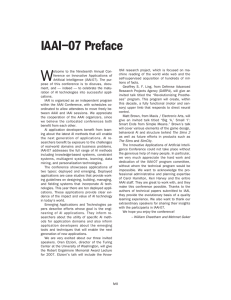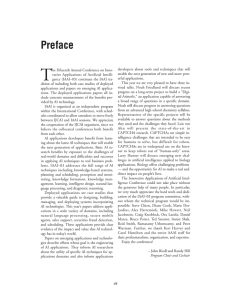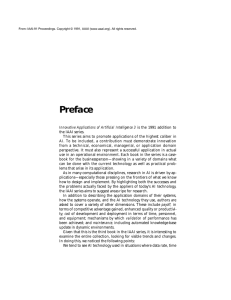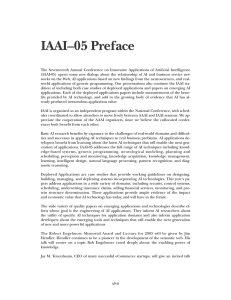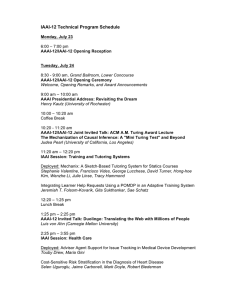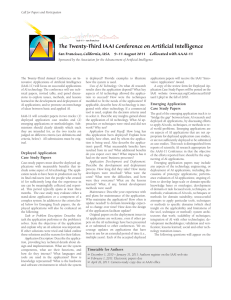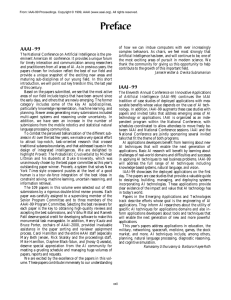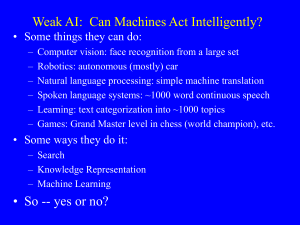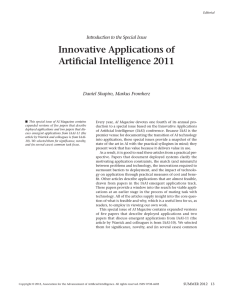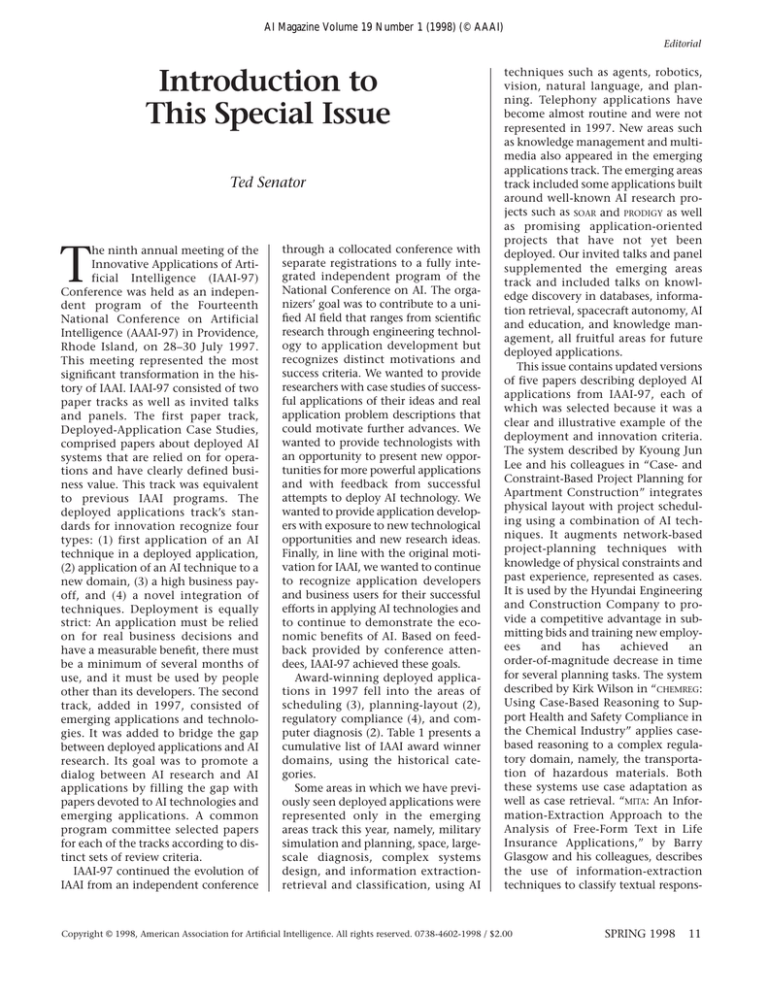
AI Magazine Volume 19 Number 1 (1998) (© AAAI)
Editorial
Introduction to
This Special Issue
Ted Senator
T
he ninth annual meeting of the
Innovative Applications of Artificial Intelligence (IAAI-97)
Conference was held as an independent program of the Fourteenth
National Conference on Artificial
Intelligence (AAAI-97) in Providence,
Rhode Island, on 28–30 July 1997.
This meeting represented the most
significant transformation in the history of IAAI. IAAI-97 consisted of two
paper tracks as well as invited talks
and panels. The first paper track,
Deployed-Application Case Studies,
comprised papers about deployed AI
systems that are relied on for operations and have clearly defined business value. This track was equivalent
to previous IAAI programs. The
deployed applications track’s standards for innovation recognize four
types: (1) first application of an AI
technique in a deployed application,
(2) application of an AI technique to a
new domain, (3) a high business payoff, and (4) a novel integration of
techniques. Deployment is equally
strict: An application must be relied
on for real business decisions and
have a measurable benefit, there must
be a minimum of several months of
use, and it must be used by people
other than its developers. The second
track, added in 1997, consisted of
emerging applications and technologies. It was added to bridge the gap
between deployed applications and AI
research. Its goal was to promote a
dialog between AI research and AI
applications by filling the gap with
papers devoted to AI technologies and
emerging applications. A common
program committee selected papers
for each of the tracks according to distinct sets of review criteria.
IAAI-97 continued the evolution of
IAAI from an independent conference
through a collocated conference with
separate registrations to a fully integrated independent program of the
National Conference on AI. The organizers’ goal was to contribute to a unified AI field that ranges from scientific
research through engineering technology to application development but
recognizes distinct motivations and
success criteria. We wanted to provide
researchers with case studies of successful applications of their ideas and real
application problem descriptions that
could motivate further advances. We
wanted to provide technologists with
an opportunity to present new opportunities for more powerful applications
and with feedback from successful
attempts to deploy AI technology. We
wanted to provide application developers with exposure to new technological
opportunities and new research ideas.
Finally, in line with the original motivation for IAAI, we wanted to continue
to recognize application developers
and business users for their successful
efforts in applying AI technologies and
to continue to demonstrate the economic benefits of AI. Based on feedback provided by conference attendees, IAAI-97 achieved these goals.
Award-winning deployed applications in 1997 fell into the areas of
scheduling (3), planning-layout (2),
regulatory compliance (4), and computer diagnosis (2). Table 1 presents a
cumulative list of IAAI award winner
domains, using the historical categories.
Some areas in which we have previously seen deployed applications were
represented only in the emerging
areas track this year, namely, military
simulation and planning, space, largescale diagnosis, complex systems
design, and information extractionretrieval and classification, using AI
techniques such as agents, robotics,
vision, natural language, and planning. Telephony applications have
become almost routine and were not
represented in 1997. New areas such
as knowledge management and multimedia also appeared in the emerging
applications track. The emerging areas
track included some applications built
around well-known AI research projects such as SOAR and PRODIGY as well
as promising application-oriented
projects that have not yet been
deployed. Our invited talks and panel
supplemented the emerging areas
track and included talks on knowledge discovery in databases, information retrieval, spacecraft autonomy, AI
and education, and knowledge management, all fruitful areas for future
deployed applications.
This issue contains updated versions
of five papers describing deployed AI
applications from IAAI-97, each of
which was selected because it was a
clear and illustrative example of the
deployment and innovation criteria.
The system described by Kyoung Jun
Lee and his colleagues in “Case- and
Constraint-Based Project Planning for
Apartment Construction” integrates
physical layout with project scheduling using a combination of AI techniques. It augments network-based
project-planning techniques with
knowledge of physical constraints and
past experience, represented as cases.
It is used by the Hyundai Engineering
and Construction Company to provide a competitive advantage in submitting bids and training new employees
and
has
achieved
an
order-of-magnitude decrease in time
for several planning tasks. The system
described by Kirk Wilson in “CHEMREG:
Using Case-Based Reasoning to Support Health and Safety Compliance in
the Chemical Industry” applies casebased reasoning to a complex regulatory domain, namely, the transportation of hazardous materials. Both
these systems use case adaptation as
well as case retrieval. “MITA: An Information-Extraction Approach to the
Analysis of Free-Form Text in Life
Insurance Applications,” by Barry
Glasgow and his colleagues, describes
the use of information-extraction
techniques to classify textual respons-
Copyright © 1998, American Association for Artificial Intelligence. All rights reserved. 0738-4602-1998 / $2.00
SPRING 1998
11
Editorial
Application Domain
1989–1996
Manufacturing-design
30
1997
Total
30
Business operations
26
6
32
Finance
25
1
26
Telephony
12
Diagnostics and troubleshooting
11
2
13
Claims processing and auditing
10
2
12
Information retrieval and classification
9
12
9
Computers and software engineering
8
8
Military
6
6
Space
4
4
Table 1. A Cumulative List of IAAI Award-Winner Domains.
es on life insurance applications.1 MITA
currently processes 20,000 applications a month; it is a front end that
potentially enables automated underwriting in the insurance industry. “An
Intelligent System for Case Review and
Risk Assessment in Social Services,” by
James Nolan, describes DISXPERT, which
uses knowledge engineering and ruleinduction techniques to evaluate disability applications in New York State;
it is an extremely powerful example of
the potential for service improvement
and standardization by large-scale
deployment and distribution of a system based on well-known AI techniques. Its use has resulted not only in
productivity improvements but also
more effective disability assessments.
“CREWS_NS: Scheduling Train Crews in
The Netherlands,” by Ernesto Morgado
and João Martins, describes an application that instantiates a task-specific
tool. CREWS was developed as a generic
crew-scheduling tool over several
years, beginning on Lisp machines,
migrating to UNIX, and finally porting
to NT. Its successful application in
CREWS_NS is resulting in opportunities
for use by other organizations.
CREWS_NS has resulted in an order-ofmagnitude decrease in scheduling
time, a reduction in annual personnel
costs of $4 million, and the preservation of specialized knowledge.
12
AI MAGAZINE
Common themes of all these applications are the traditional benefit from
AI systems of knowledge dissemination to an organization, integration of
multiple AI techniques, and integration of the application with not only
the information systems environment
but also the business users’ environment. From a technology perspective,
this year saw the first deployments of
case-based reasoning systems that
used case adaptation, use of techniques from data mining, and web
deployment. A trend toward task-specific AI shells (for example, CREWS), in
addition to the more generic reasoning shells that predominated previously, might be forming. Changes in the
information system environment,
from mainframes to networked workstations and now the web, have been
reflected in the applications we have
selected for IAAI. Finally, as AI is
becoming more embedded and integrated, it is more useful but less visible,
which is a sign of a maturing technology.
Much of the difficulty in creating an
AI application comes from the complexity of the environment in which
the application must operate. This
environment is typically part of a large
information system, which in itself is
part of a business user organization.
Issues faced by application developers
include not only selection, trade-offs,
and integration of appropriate AI techniques but also integration into the
information system environment and
the business environment in which
the system is to be used. AI research
has benefited from the challenge of
creating integrated artifacts that can
exist in a complex environment; successful AI applications have, of necessity, faced and overcome similar challenges.
IAAI has benefited over the years
from the long-term commitments and
efforts of many program committee
members; their role in providing a stable evolution of the conference has
been essential to its success, and I
would like to thank them once again
for their efforts with regard to IAAI-97.
I believe that the revitalized IAAI
structure will serve the entire AI community as we move forward to 1998
and beyond, discovering new insights,
developing new technologies, and
providing useful capabilities.
Note
1. This application was presented as part of
the Emerging Areas Track because it had
not been deployed sufficiently at the time
of review; it met the criteria in time for the
conference and will receive the Innovative
Application Award next year.

